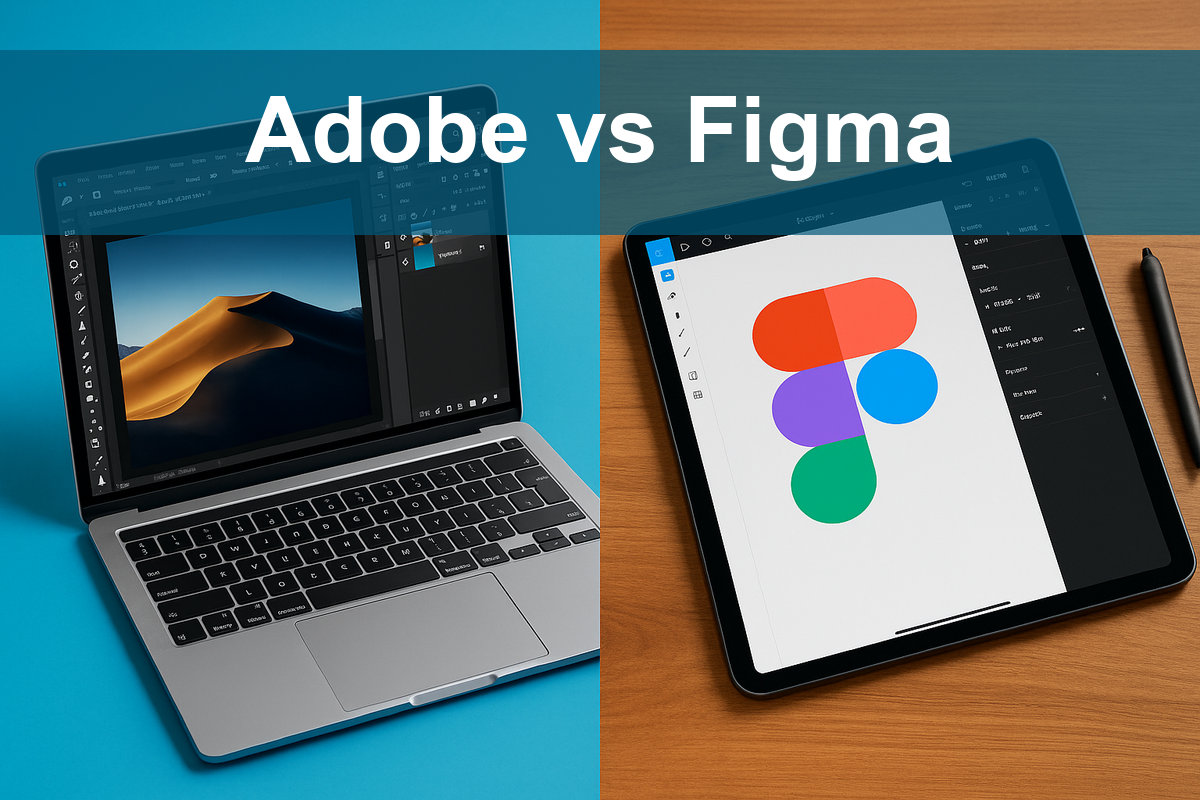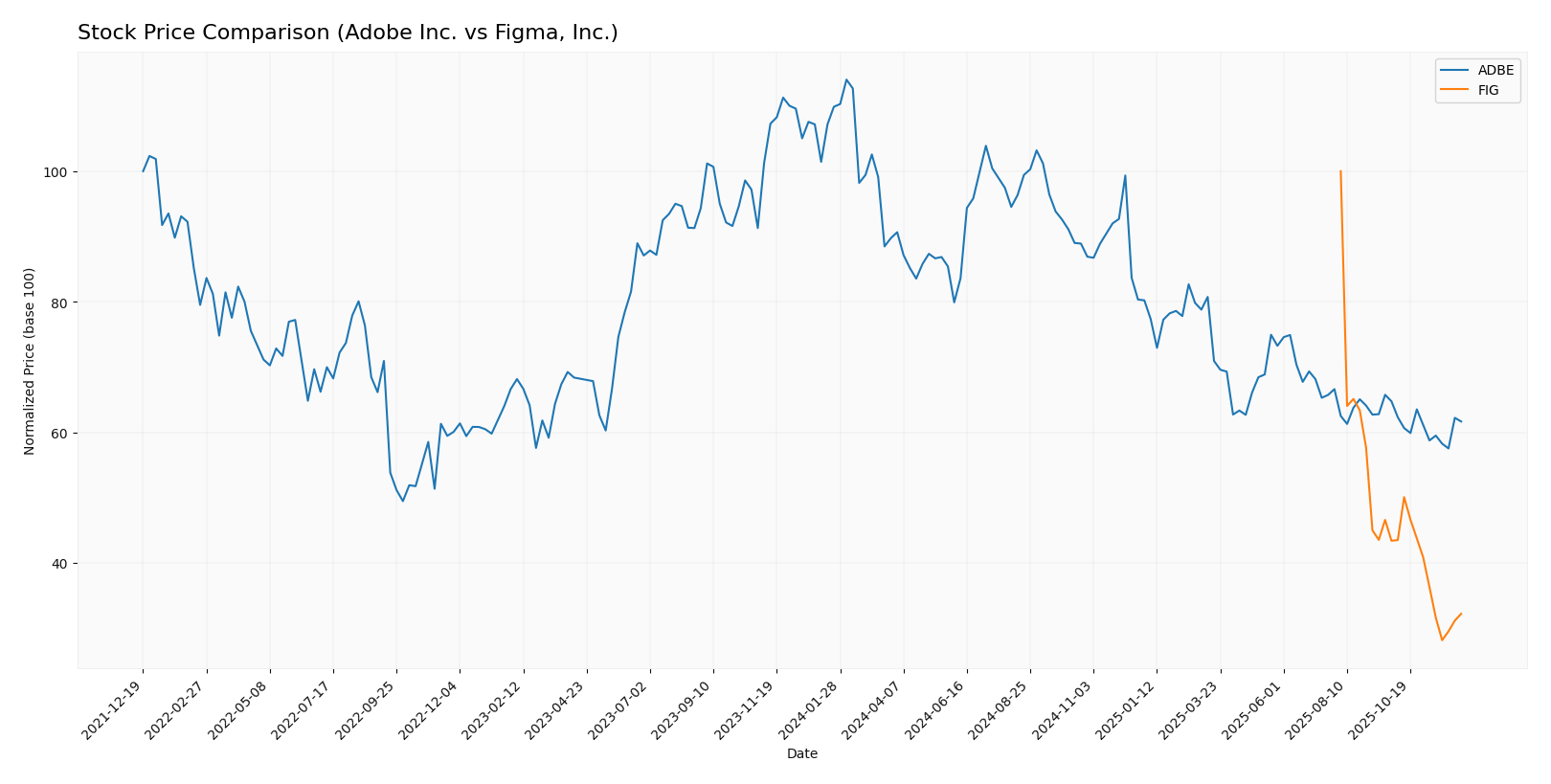In the dynamic world of technology, two companies stand out for their innovative approaches to software development: Adobe Inc. and Figma, Inc. While Adobe has established itself as a leader in digital media solutions, Figma is quickly gaining traction with its user-friendly design tools tailored for collaborative environments. Both companies operate within the software industry, but their strategies and target markets differ significantly. In this article, I will help you determine which company may be the more intriguing investment for your portfolio.

Table of contents
Company Overview
Adobe Inc. Overview
Adobe Inc. is a leading diversified software company renowned for its innovative solutions in the digital media and digital experience domains. Founded in 1982 and headquartered in San Jose, California, Adobe operates primarily through three segments: Digital Media, Digital Experience, and Publishing and Advertising. Its flagship product, Creative Cloud, offers subscription-based access to a suite of creative tools, catering to content creators and enterprises alike. The Digital Experience segment empowers brands to optimize customer interactions through analytics and commerce solutions. With a market capitalization of approximately $144B, Adobe maintains a strong market position, continually adapting to the evolving needs of its diverse clientele.
Figma, Inc. Overview
Figma, Inc., established in 2012 and based in San Francisco, California, specializes in browser-based design tools that facilitate collaboration among design and development teams. The company’s flagship product, Figma Design, enables teams to explore ideas and streamline product development efficiently. Its additional offerings include Dev Mode for code translation, FigJam for collaborative brainstorming, and Figma Slides for presentations, all designed to enhance productivity in design workflows. With a market cap of around $19B, Figma is recognized for its innovative approach to user interface design, appealing to modern digital teams.
Key similarities and differences
Both Adobe and Figma operate in the technology sector with a focus on design and creative software. While Adobe offers a broader range of tools across various segments, Figma stands out for its collaborative, web-based platform tailored for design teams. Adobe emphasizes a comprehensive suite of solutions, whereas Figma prioritizes user-friendly, real-time collaboration in design processes.
Income Statement Comparison
The following table compares the income statements of Adobe Inc. and Figma, Inc. for the most recent fiscal year, providing insights into their financial performance.
| Metric | Adobe Inc. (ADBE) | Figma, Inc. (FIG) |
|---|---|---|
| Market Cap | 144B | 19.1B |
| Revenue | 23.8B | 749M |
| EBITDA | 8.7B | -87M |
| EBIT | 8.7B | -877M |
| Net Income | 7.1B | 286M |
| EPS | 16.73 | 0.59 |
| Fiscal Year | 2025 | 2024 |
Interpretation of Income Statement
In the most recent fiscal year, Adobe demonstrated solid growth with a 10.7% increase in revenue compared to the previous year, resulting in a net income of 7.1B. This reflects strong operational efficiency, as evidenced by an EBITDA margin improvement. Conversely, Figma’s revenue increased to 749M, but the company reported a net income of just 286M, indicating its ongoing investment strategy may be affecting profitability. While Adobe’s margins improved, Figma continues to face challenges, reflected in its negative EBITDA and EBIT figures, necessitating a careful approach for potential investors.
Financial Ratios Comparison
The table below provides a comparison of key financial metrics for Adobe Inc. (ADBE) and Figma, Inc. (FIG), focusing on their most recent revenue and financial ratios.
| Metric | Adobe Inc. (ADBE) | Figma, Inc. (FIG) |
|---|---|---|
| ROE | 39.4% | -55.3% |
| ROIC | 25.4% | -59.3% |
| P/E | 19.1 | -70.7 |
| P/B | 16.4 | 39.1 |
| Current Ratio | 1.07 | 3.66 |
| Quick Ratio | 1.07 | 3.66 |
| D/E | 0.43 | 0.02 |
| Debt-to-Assets | 20.0% | 1.6% |
| Interest Coverage | 41.1 | N/A |
| Asset Turnover | 0.71 | 0.42 |
| Fixed Asset Turnover | 9.7 | 49.9 |
| Payout Ratio | 0% | 0% |
| Dividend Yield | 0% | 0% |
Interpretation of Financial Ratios
Adobe Inc. demonstrates strong profitability metrics with a high return on equity (ROE) and return on invested capital (ROIC), indicating effective management of equity and capital. In contrast, Figma exhibits negative returns, suggesting significant operational challenges. ADBE’s current and quick ratios are healthy, implying good liquidity, while FIG’s ratios suggest a robust short-term financial position. However, Figma’s inflated P/E ratio reflects high valuation risk, despite its low debt levels. Investors should remain cautious given the contrasting financial health of these two companies.
Dividend and Shareholder Returns
Adobe Inc. (ADBE) does not pay dividends, reflecting its focus on reinvesting earnings for growth, particularly in software development and acquisitions. The company engages in share buybacks, utilizing excess cash flow to enhance shareholder value, albeit with potential risks of unsustainability. Figma, Inc. also does not distribute dividends, prioritizing reinvestment during its growth phase. This strategy aligns with long-term value creation, although both companies must manage the risks associated with heavy reinvestment and debt levels.
Strategic Positioning
Adobe Inc. (ADBE) holds a significant market share in the software infrastructure sector, driven by its flagship Creative Cloud product. With a market cap of approximately $144B, it faces competitive pressure from Figma, Inc. (FIG), which is carving out a niche in collaborative design tools. Figma’s recent IPO and rapid growth, with a market cap of around $19B, highlight the potential for technological disruption within the design software market. As both companies innovate, the competitive landscape is evolving, necessitating strategic agility.
Stock Comparison
In this section, I will analyze the stock performance of Adobe Inc. (ADBE) and Figma, Inc. (FIG) over the past year, highlighting key price movements and trading dynamics that could influence investment decisions.

Trend Analysis
Adobe Inc. (ADBE) has experienced a significant decline of -43.89% over the past year. This bearish trend is marked by notable acceleration, with a recent drop of -4.78% from September 28, 2025, to December 14, 2025. The stock reached a high of 634.76 and a low of 320.13, indicating substantial volatility, as evidenced by a standard deviation of 83.29. The trend shows acceleration, suggesting continued selling pressure.
Figma, Inc. (FIG) has also faced a considerable downturn, with a total price change of -67.82% over the past year. Similar to Adobe, this bearish trend is accelerating, particularly with a recent decline of -25.8% during the same period. The stock’s highest price was 122.0, while it dropped to a low of 34.31, reflecting volatility with a standard deviation of 20.04. The acceleration in this bearish trend indicates increasing selling activity.
Both stocks exhibit bearish trends, prompting caution for potential investors.
Analyst Opinions
Recently, analysts have expressed strong confidence in Adobe Inc. (ADBE), with ratings predominantly at “Buy.” A notable recommendation comes from an analyst who highlighted strong performance metrics, particularly in return on equity and assets, solidifying ADBE’s position as a market leader. In contrast, Figma, Inc. (FIG) has received mixed reviews, with a “Hold” rating reflecting concerns regarding its return on equity. Despite this, FIG’s robust performance in return on assets keeps it on the analysts’ radar. Overall, the consensus for ADBE is a strong “Buy,” while FIG leans towards “Hold.”
Stock Grades
In this section, I present the latest stock ratings for Adobe Inc. and Figma, Inc., based on reliable grading data from recognized firms.
Adobe Inc. Grades
| Grading Company | Action | New Grade | Date |
|---|---|---|---|
| Stifel | maintain | Buy | 2025-12-09 |
| Citigroup | maintain | Neutral | 2025-12-04 |
| DA Davidson | maintain | Buy | 2025-11-20 |
| Mizuho | maintain | Outperform | 2025-11-20 |
| Wells Fargo | maintain | Overweight | 2025-11-20 |
| Morgan Stanley | downgrade | Equal Weight | 2025-09-24 |
| DA Davidson | maintain | Buy | 2025-09-12 |
| JMP Securities | maintain | Market Perform | 2025-09-12 |
| Evercore ISI Group | maintain | Outperform | 2025-09-12 |
| Piper Sandler | maintain | Overweight | 2025-09-12 |
Figma, Inc. Grades
| Grading Company | Action | New Grade | Date |
|---|---|---|---|
| Goldman Sachs | maintain | Neutral | 2025-11-07 |
| JP Morgan | maintain | Neutral | 2025-11-06 |
| Piper Sandler | maintain | Overweight | 2025-11-06 |
| Wells Fargo | maintain | Equal Weight | 2025-11-05 |
| Wells Fargo | maintain | Equal Weight | 2025-09-04 |
| Morgan Stanley | maintain | Equal Weight | 2025-09-04 |
| RBC Capital | maintain | Sector Perform | 2025-09-04 |
Overall, the trend for Adobe shows a solid standing with multiple “Buy” and “Outperform” ratings, although a recent downgrade to “Equal Weight” by Morgan Stanley indicates some caution. Figma maintains a mostly neutral sentiment, reflecting stability with several “Equal Weight” and “Neutral” grades, suggesting a balanced investor outlook.
Target Prices
The consensus target prices from analysts indicate potential growth for both Adobe Inc. and Figma, Inc.
| Company | Target High | Target Low | Consensus |
|---|---|---|---|
| Adobe Inc. | 500 | 280 | 420 |
| Figma, Inc. | 80 | 48 | 63.75 |
For Adobe Inc. (ADBE), the target consensus of 420 suggests a significant upside compared to its current price of 343.13. Meanwhile, Figma, Inc. (FIG) shows a consensus of 63.75, indicating potential growth from the current price of 39.26.
Strengths and Weaknesses
The following table summarizes the strengths and weaknesses of Adobe Inc. (ADBE) and Figma, Inc. (FIG) based on the most recent financial data.
| Criterion | Adobe Inc. (ADBE) | Figma, Inc. (FIG) |
|---|---|---|
| Diversification | High | Moderate |
| Profitability | Strong (30% net margin) | Weak (Negative margin) |
| Innovation | High | High |
| Global presence | Extensive | Limited |
| Market Share | Significant | Growing |
| Debt level | Low (0.2 debt-to-assets) | Very low (0.01 debt-to-assets) |
Key takeaways: Adobe maintains strong profitability and extensive global reach, while Figma shows high innovation potential but currently struggles with profitability. Diversification and debt levels favor both companies, but their market positions differ significantly.
Risk Analysis
Below is a summary of the key risks associated with Adobe Inc. (ADBE) and Figma, Inc. (FIG):
| Metric | Adobe Inc. | Figma, Inc. |
|---|---|---|
| Market Risk | Moderate | High |
| Regulatory Risk | Low | Moderate |
| Operational Risk | Moderate | High |
| Environmental Risk | Low | Low |
| Geopolitical Risk | Moderate | Moderate |
In my analysis, Figma faces significant operational and market risks, evidenced by its unstable profitability metrics and high price-to-earnings ratio (181.1). On the other hand, Adobe’s established market position mitigates some risks, but it still faces moderate operational and market risks due to competitive pressures and global economic conditions.
Which one to choose?
When comparing Adobe Inc. (ADBE) and Figma, Inc. (FIG), Adobe appears more favorable for long-term investors. ADBE shows a robust market cap of 136.4B and an impressive net profit margin of 30%, alongside a solid debt-to-equity ratio of 0.43, indicating stability. The stock trend for ADBE is currently bearish, with a price drop of approximately 43.89% over the past year.
Conversely, Figma’s metrics reveal challenges; it has a negative net income and a high price-to-sales ratio of 69.1, reflecting significant valuation concerns. Figma holds a market cap of 117.4B but has a less favorable rating of B compared to ADBE’s A.
For growth-focused investors, ADBE stands out due to its established presence and solid fundamentals, while those prioritizing speculative opportunities might consider FIG, albeit with higher risks related to competition and market volatility.
Disclaimer: This article is not financial advice. Each investor is responsible for their own investment decisions.
Go further
I encourage you to read the complete analyses of Adobe Inc. and Figma, Inc. to enhance your investment decisions:



